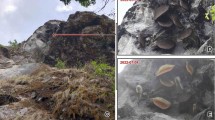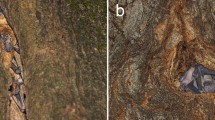Abstract
A unique and novel stereotypic ‘smearing’ behavior and the formation of an odoriferous dorsal patch have been recently described in two species of long-nosed bats, Leptonycteris curasoae and L. yerbabuenae (Glossophaginae: Phyllostomidae). It has been hypothesized that this structure represents a mechanism involved in female mate choice mediated through odor, and that it has only evolved within the genus Leptonycteris. No evidence has been published indicating whether the smearing behavior and the dorsal patch occur in L. nivalis, the third extant species within the genus. We reviewed the available data on the mating behavior of L. nivalis and conducted four surveys on the only mating colony known for this species at Cueva del Diablo, Tepoztlan, Morelos, Mexico, searching for evidence of both the smearing behavior and the dorsal patch in reproductive males of this species. Our findings indicate that L. nivalis does not display the smearing behavior or the dorsal patch, suggesting that this trait and its role in mate choice by females must have evolved from a common ancestor of L. yerbabuenae and L. curasoae after it separated from L. nivalis, between 1.0 and 0.5 million years ago. We propose a possible hypothetical scenario for the evolution of the smearing behavior, based on differential levels of ectoparasitic pressure acting on bat populations established at locations with markedly different environmental temperatures.
Similar content being viewed by others
References
Arita, H.T., 1991. Spatial segregation in long-nosed bats, Leptonycteris nivalis and Leptonycteris curasoae, in Mexico. J. Mammal. 72, 706–714.
Arroyo-Cabrales, J., Polaco, O.J., 2003. Caves and the Pleistocene vertebrate paleontology of Mexico. In: Schubert, B.W., Mead, J.I., Graham, R.W. (Eds.), Studies of Vertebrate Cave Life During the North American Ice Age. Indiana University Press, Indiana, pp. 273–291.
Axelrod, D.I., 1979. Age and origin of the Sonoran desert vegetation. Occas. Pap. Calif. Acad. Sci. 132, 1–74.
Ayala-Berdon, J., Galicia, R., Flores-Ortíz, C., Medellín, R., Schondube, J.E., 2013. Digestive capacities allow the Mexican long-nosed bat (Leptonycteris nivalis) to live in cold environments. Comp. Biochem. Physiol. Part A Mol. Integr. Physiol. 164, 622–628.
Bordes, F., Morand, S., Ricardo, G., 2008. Bat fly species richness in Neotropical bats: correlations with host ecology and host brain. Oecologia 158, 109–116.
Brown, CM., 2008. Natural History and Population Genetics of the Endangered Mexican Long-Nosed Bat, Leptonycteris nivalis (Chiroptera: Phyllostomidae). Master Thesis. Angelo State University, US, 64 pps.
Caballero-Martínez, LA., 2004. Observaciones sobre la conducta reproductiva de Leptonycteris nivalis (Chiroptera: Phyllostomidae) enTepoztlán, Morelos, México. Licenciatura Thesis. Facultad de Ciencias, UAEM, Mexico, 118 pps.
Ceballos, G., Fleming, T.H., Chávez, C., Nassar, J.M., 1997. Population dynamics of Leptonycteris curasoae (Chiroptera: Phyllostomidae) in Jalisco, Mexico. J. Mammal. 78, 1220–1230.
Christe, P., Arlettaz, R., Vogel, P., 2000. Variation in intensity of a parasitic mite (Spinturnix myoti) in relation to the reproductive cycle and immunocompetence of its bat host (Myotis myotis). Ecol. Lett. 3, 212–307.
Cole, F.R., Wilson, D.E., 2006. Leptonycteris yerbabuenae. Mammal. Species 797, 1–7.
Gray, J.S., Dautel, H., Estrada-Peña, A., Kahl, O., Lindgren, E., 2009. Effects of climate change on ticks and tick-borne diseases in Europe. Interdiscip. Perspect. Infect. Dis., https://doi.org/10.1155/2009/593232.
Hensley, A.P., Wilkins, K.T., 1988. Leptonycteris nivalis. Mammal. Species 307, 1–4.
Hoffman, A., Palacios-Vargas, J.G., Morales-Malacara, J.B., 1986. Manual de Bioespeleología (Con nuevas aportaciones de Morelos y Guerrero, México), 2nd ed. UNAM, Mexico.
IUCN, 2016. IUCN Red List, https://doi.org/www.iucnredlist.org/ (accessed 05.03.16. López-Segurajáuregui, G., Toledo-Gutiérrez, K., Medellín, R.A., 2006. Cueva del Diablo: a Bat cave inTepoztlán. AMCS Bull. 19/SMES Bol. 7, 264–270.
Lourenco, S., Palmeirim, J.M., 2008. Which factors regulate the reproduction of ectoparasites of temperate-zone cave-dwelling bats? Parasitol. Res. 104, 127–134.
Marshall, A.G., 1982. Ecology of ectoparasitic insects on bats. In: Kunz, T.H. (Ed.), Ecology of Bats. Plenum Publishing Corporation, New York, London, pp. 369–399.
Merino, S., Potti, J., 1996. Weather dependent effects of nest ectoparasites on their bird hosts. Ecography 19, 107–113.
Moreno-Valdéz, A., Honeycutt, R.L., Grant, W.E., 2004. Colony dynamics of Leptonycteris nivalis (Mexican long-nosed bat) related to flowering Agave in northern Mexico. J. Mammal. 85, 453–459.
Muñoz-Romo, M., Kunz, T.H., 2009. Dorsal patch and chemical signaling in males of the long-nosed bat, Leptonycteris curasoae (Chiroptera: Phyllostomidae). J. Mammal. 90, 1139–1147.
Muñoz-Romo, M., Burgos, J.F., Kunz, T.H., 2011a. Smearing behaviour of male Leptonycteris curasoae (Chiroptera) and female responses to the odour of dorsal patches. Behaviour 148, 461–483.
Muñoz-Romo, M., Burgos, J.F., Kunz, T.H., 2011b. The dorsal patch of males of the Curañaoan long-nosed bat, Leptonycteris curasoae (Phyllostomidae: Glossophaginae) as a visual signal. Acta Chiropterol. 13, 207–215.
Muñoz-Romo, M., Nielsen, L.T., Nassar, J.M., Kunz, T.H., 2012. Chemical composition of the substances from dorsal patches of males of the Curañaoan long-nosed bat, Leptonycteris curasoae (Phyllostomidae: Glossophaginae). Acta Chiropterol. 14, 213–224.
Nassar, J.M., Salazar, M.V., Quintero, A., Stoner, K.E., Gómez, M., Cabrera, A., Jaffe, K., 2008. Seasonal sebaceous patch in the nectar-feeding bats Leptonycteris curasoae and L. yerbabuenae (Phyllostomidae: Glossophaginae): phenological, histological, and preliminary chemical characterization. Zoology 111, 363–376.
Patterson, D.B., Dick, W.C., Dittmar, K., 2007. Roosting habits of bats affect their parasitism by bat flies (Diptera: Streblidae).J. Trop. Ecol. 23, 177–189.
Pilosof, S., Dick, C.W., Korine, C., Patterson, B.D., Krasnov, B.R., 2012. Effects of anthropogenic disturbance and climate on patterns of bat fly parasitism. PLoS One 7, e41487.
Reid, F.R., 1997. A Field Guide to the Mammals of Central America and Southeast Mexico. Oxford University Press, New York.
Rincón-Vargas, F., Stoner, K.E., Vigueras-Villaseñor, R.M., Nassar, J.M., Cháves, O.M., Hudson, R., 2013. Internal and external indicators of the male reproductive cycle in the long-nosed bat Leptonycteris yerbabuenae. J. Mammal. 94, 488–496.
Schad, J., Dechmann, D.K.N., Voigt, C.C., Sommer, S., 2012. Evidence for the ‘good genes’ model: association of MHC class II DRB alleles with ectoparasitism and reproductive state in the neotropical lesser bulldog bat, Noctilio albiventris. PLoS One, 7, https://doi.org/10.1371/journal.pone.0037101.
SEMARNAT, 2010. Norma Oficial Mexicana NOM-059-SEMARNAT-2010. (2010). Protección ambiental-Especies nativas de México de flora y fauna silvestres-Categorías de riesgo y especificaciones para su inclusión, exclusión o cambio-Lista de especies en riesgo. Diario Oficial de la Federación 30/12/2010.
Stoner, K.E., Salazar, K.A.O., Fernández, R.C.R., Quesada, M., 2003. Population dynamics, reproduction, and diet of the lesser long-nosed bat (Leptonycteris curasoae) in Jalisco, Mexico: implications for conservation. Biodivers. Conserv. 12, 357–373.
Téllez, J.G., 2001. Migración de los murciélagos-hocicudos (Leptonycteris) en el trópico mexicano. Tesis de licenciatura para obtener el grado de Biólogo. Universidad Nacional Autónoma de México (UNAM), 146 pps.
Tlapaya-Romero, L., Horvath, A., Gallina-Tessaro, S., Naranjo, E.J., Gómez, B., 2015. Prevalencia y abundancia de moscas parásitas asociadas a una comunidad de murciélagos cavernícolas en La Trinitaria, Chiapas, Mexico. Rev. Mex. Biodivers. 86, 377–385.
Toledo-Gutiérrez, K.P., 2009. Hábitos reproductivos del murciélago magueyero mayor Leptonycteris nivalis (Chiroptera: Phyllostomidae) en la Cueva del Diablo, Tepoztlán, Morelos, México. Licenciatura Thesis. Universidad Nacional Auntónoma de México, Mexico.
U.S. Fish and Wildlife Service, 1994. Plan de recuperación del murciélago magueyero (Leptonycteris nivalis). Albuquerque, Nuevo México.
Villa-R, B., 1967. Los murciélagos de México. Instituto de Biología, Universidad Nacional Autónoma de México, Mexico.
Wilkinson, G.S., Fleming, T.H., 1996. Migration and evolution of lesser long-nosed bats Leptonycteris curasoae: inferred from mitochondrial DNA. Mol. Ecol. 5, 329–339.
Wilson, D.E., Medellín, R.A., Lanning, D.V., Arita, H.T., 1985. Los murciélagos del noreste de México, con una lista de especies. Acta Zool. Mex. (Nueva serie) 8, 1–26.
ter Hofstede, H.M., Fenton, M.B., 2005. Relationships between roost preferences, ectoparasite density, and grooming behaviour of neotropical bats. J. Zool. (London) 266, 333–340.
Author information
Authors and Affiliations
Corresponding author
Rights and permissions
About this article
Cite this article
Nassar, J.M., Galicia, R., Ibarra, A. et al. Tracking the origin of the smearing behavior in long-nosed bats (Leptonycteris spp.). Mamm Biol 81, 623–627 (2016). https://doi.org/10.1016/j.mambio.2016.08.003
Received:
Accepted:
Published:
Issue Date:
DOI: https://doi.org/10.1016/j.mambio.2016.08.003




